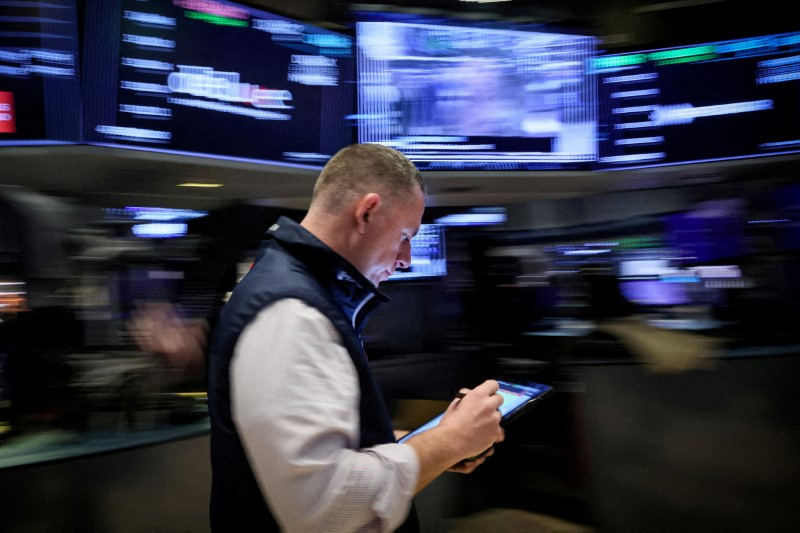By Yoruk Bahceli and Dhara Ranasinghe
(Reuters) - Disappointing U.S. jobs data has shaken confidence in a soft landing for the world's largest economy, sending global equity markets tumbling and bets on interest rate cuts surging.
But investors abandoning a popular yen carry trade has played a big role in the selloff, complicating the message from asset prices on the economic outlook.
The likelihood of a recession is anyone's guess. Goldman Sachs (NYSE:GS) has raised its odds of a U.S. recession to 25%. JPMorgan (NYSE:JPM) sees a 35% chance of one starting before year-end.
Here is what five closely-watched market indicators say about global recession risks:
1/ DATA PUZZLE
The U.S. unemployment rate jumped near a three-year high of 4.3% in July amid a significant slowdown in hiring.
It fanned recession fears by reaching a trigger point of the "Sahm rule", which has shown historically a recession is underway when the three-month rolling average unemployment rate rises half a percentage point above the low of the prior 12 months.
Still, many economists reckon the reaction to the data was overblown given the numbers may be skewed by immigration and Hurricane Beryl. Better-than-expected jobless claims data on Thursday also supported that view, sending stocks rallying.
"Payrolls are still growing. If you started to see payrolls turn negative, that would make me much more concerned that a genuine recession is starting," said Dario Perkins, managing director, global macro at consultancy TS Lombard.
The U.S. economy grew 2.8% in the second quarter on an annualised basis, double the first quarter rate and on par with the pre-pandemic average. Services activity also points to growth continuing.
Beyond the United States, however, business activity indicators point to faltering euro zone growth, while China's recovery remains fragile.
Global economic data is delivering negative surprises near the highest rate since mid-2022, Citi's surprise index shows.
2/ CORPORATE ROUT
MSCI's global stocks index is down more than 6% from July's record highs, while the U.S. S&P 500 has lost over 4% so far in August.
Yet analysts reckon stocks, which are still up around 7% globally this year, are far from signalling a recession.
Goldman Sachs estimates that every further 10% selloff in U.S. equities would reduce growth over the next year by just under half a percentage point.
Credit conditions could prove more important, analysts say.
They note that although the risk premium corporate bonds pay over government bonds has widened in Europe and the United States, it was correcting from historically tight levels and moves were not yet pronounced enough to suggested recession risks were high.
Recession expectations implied by the gap between U.S. investment grade bond and Treasury yields are about half as high as they were in 2022-2023, according to BofA.
3/ CUT AWAY
Spurred on by the U.S. jobs data and a dovish-sounding Federal Reserve, traders now price in around 100 basis points of cuts in U.S. rates by year-end.
That is down from over 130 bps earlier this week, but double the roughly 50 bps anticipated on July 29. Markets also price in more than a 50% chance of a hefty 50 bps September cut.
Major banks have also added to the Fed cuts they expect this year.
Steve Ryder, portfolio manager at Aviva (LON:AV) Investors, said the Fed was likely to cut rates three times this year, but given uncertainty around how economic data evolves, it was understandable that markets were pricing the probability that it would have to cut more.
Elsewhere, traders see a high chance of three more European Central Bank rate cuts this year, having seen less than a full chance of a second cut in mid-July.
4/ YIELD CURVE
Rate cut bets have sent shorter-dated U.S. Treasury yields tumbling and the closely-watched part of the yield curve that tracks the gap between 10-year and 2-year Treasury yields turned positive for the first time since July 2022 on Monday.
While a yield curve inversion has historically been seen as a good predictor of a recession on the horizon, the curve tends to revert back to normal as the recession nears.
However, with the curve inverted for a record time this cycle with no recession materialising, a majority of strategists Reuters polled earlier this year no longer see it as a reliable recession indicator.
The curve has inverted back since, standing at minus 5 basis points on Thursday.
5/ DR COPPER
Known as "Dr Copper" for its track record as a boom-bust indicator, the metal's fall to 4-1/2 month lows this week puts it firmly on the recession watch list.

Trading at around $8,750 a metric ton, three-month London Metal Exchange copper prices have slumped roughly 20% from a record high scaled in May, reflecting pessimism about the global economic outlook.
Oil prices, another barometer of the health of global demand, are near multi-month lows. But their fall has been limited by worries that Middle East tensions could squeeze supplies from the largest oil producing region.